|
Opening Moves:
Marines Gear Up for War
Marines in World War II
by Henry I. Shaw, Jr. |
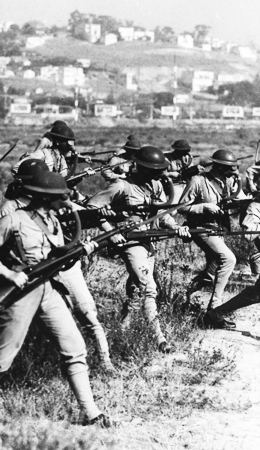
|
|
Opening Moves:
Marines Gear Up for War
Marines in World War II
by Henry I. Shaw, Jr. |

|
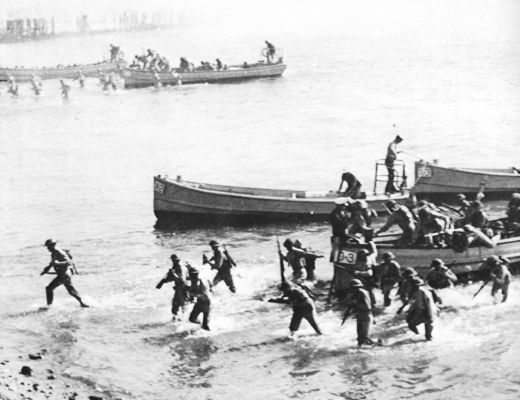 |
| U.S. Marines go ashore from Navy motor-sailers in the prewar era before the advent of
Andrew Higgins' landing craft. (Department of Defense [USN] Photo 58920) |
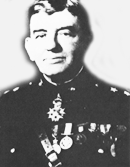 MajGen John A. Lejeune, 13th Commandant of the Marine Corps, led the Corps in the 1920s, steadfastly emphasizing the expeditionary role of Marines.
MajGen John A. Lejeune, 13th Commandant of the Marine Corps, led the Corps in the 1920s, steadfastly emphasizing the expeditionary role of Marines.
(Department of Defense [USMC] Photo 308342)
------------------------------------------------------
On 1 September 1939, German armored columns and attack aircraft crossed the Polish border on a broad front and World War II began. Within days, most of Europe was deeply involved in the conflict as nations took sides for and against Germany and its leader, Adolph Hitler, according to their history, alliances, and self-interest. Soviet Russia, a natural enemy of Germany's eastward expansion, became a wary partner in Poland's quick defeat and subsequent partition in order to maintain a buffer zone against the German advance. Inevitably, however, after German successes in the west and the fall of France, Holland, and Belgium, in 1940, Hitler attacked Russia, in 1941.
In the United States, a week after the fighting in Poland started, President Franklin D. Roosevelt declared a limited national emergency, a move which, among other measures, authorized the recall to active duty of retired Armed Forces regulars. Even before this declaration, in keeping with the temper of the times, the President also stated that the country would remain neutral in the new European war. During the next two years, however, the United States increasingly shifted from a stance of public neutrality to one of preparation for possible war and quite open support of the beleaguered nations allied against Germany.
America could not concentrate its attention on Europe alone in those eventful years, for another potential enemy dominated the Far East. In September 1940, Japan became the third member, with Germany and Italy, of the Axis powers. Japan had pursued its own program of expansion in China and elsewhere in the 1930s which directly challenged America's interests. Here too, in the Pacific arena, the neutral United States was moving toward actions, political and economic, that could lead to a clash with Japan.
In this hectic world atmosphere, America began to build its military strength. Shortly before Germany attacked Poland, at mid-year 1939, the number of active duty servicemen stood at 333,473: 188,839 in the Army, 125,202 in the Navy, and 19,432 in the Marine Corps. A year later, the overall strength was 458,365 and the number of Marines was 28,345. By early summer of 1941, the Army had 1,801,101 soldiers on active duty, many of them National Guardsmen and Reservists, but most of them men enlisted after Congress authorized a peacetime draft. The Navy, also augmented by the recall of Reservists, had 269,023 men on its active rolls. There were 54,359 Marines serving on 1 July 1941, all the Reservists available and a steadily increasing number of volunteers. Neither the Navy nor the Marine Corps had need for the draft to fill their ranks.
The Marine Corps that grew in strength during 1939-41 was a Service oriented toward amphibious operations and expeditionary duty. It also had a strong commitment to the Navy beyond its amphibious/expeditionary roles as it provided Marine detachments to guard naval bases on board capital ships throughout the world. Marine aviation squadrons--all Marine pilots were naval aviators and many were carrier qualified--reinforced the Navy's air arm.
Two decades of air and ground campaigns in the Caribbean and Central America, the era of the "banana wars," had ended in 1934 when the last Marines withdrew from Nicaragua, having policed the election of a new government. With their departure, enough men became available to have meaningful fleet landing exercises (FLEXs) which tested doctrine, troops, and equipment in partnership with the Navy. And the doctrine tested was both new and important.
Throughout the 1920s, when Major General Commandant John A. Lejeune led the Corps, the doughty World War I commander of, briefly, the renowned 4th Marine Brigade, and then its parent 2d Infantry Division, had steadfastly emphasized the expeditionary role of Marines. Speaking tot he students and faculty of the Naval War College in 1923, Lejeune said: "The maintenance, equipping, and training of its expeditionary force so it will be in instant readiness to support the Fleet in the event of War, I deem to be the most important Marine Corps
duty in time of peace." But the demands of that same expeditionary duty, with Marines deployed in the Caribbean, in Central America, in the Philippines, and in China stretched the Corps thin.
 Marines bring ashore a disassembled 75mm pack howitzer. The pack howitzer replaced the French 75, which had served Marine artillery from World War I.
Marines bring ashore a disassembled 75mm pack howitzer. The pack howitzer replaced the French 75, which had served Marine artillery from World War I.
Marine Corps Historical Collection
----------------------------------------
Existing doctrine for amphibious operations, both in assault and defense, the focal point of wartime service by Marines, was recognized as inadequate. All sorts of deficiencies existed, in amphibious purpose, in shipping, in landing craft, in the areas of air and naval gunfire support, and particularly in the methodology and logistics of the highly complicated ship-to-shore movement of troops and their supplies once ashore.
The men who succeeded Lejeune as Major General Commandant upon his retirement after two terms in office (eight years) at the Corps' helm, Wendel C. "Buck" Neville, also a wartime commander of the 4th Marine Brigade, Ben M. Fuller, who commanded a brigade in Santo Domingo during the war, and John H. Russell, Jr., a brigade commander in Haiti who then became America's High Commissioner in that country for eight years, all shared Lejeune's determination that the Marine Corps would have a meaningful role as an amphibious force trained for expeditionary use by the Navy. Each man left his own mark upon the Corps in an era of reduced appropriations and manpower as a result of the Depression that plagued the United States during their tenure.
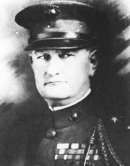 MajGen Wendell C. Neville, 14th Commandant of the Marine Corps, died after serving little more than a year in office. Neville shared Lejeune's determination that the Marine Corps have a meaningful role as an amphibious force trained for expeditionary use by the Navy.
MajGen Wendell C. Neville, 14th Commandant of the Marine Corps, died after serving little more than a year in office. Neville shared Lejeune's determination that the Marine Corps have a meaningful role as an amphibious force trained for expeditionary use by the Navy.
Department of Defense Photo (USMC) 303062
------------------------------------------------------
Neville, who had been awarded the Medal of Honor for his part in the fighting at Vera Cruz in 1914, unfortunately died after serving little more than a year (1929-1930) as Commandant, but his successors, Fuller (1930-1934) and Russell (1934-1936), both served to age 64, then the mandatory retirement age for senior officers. All of these Commandants, as Lejeune, were graduates of the U.S. Naval Academy at Annapolis and had served two years as naval cadets on board warships after graduation and before accepting commissions as Marine second lieutenants. As a consequence, their understanding of the Navy was pervasive as was their conviction that the Marine Corps and the Navy were inseparable partners in amphibious operations. In this instance, the Annapolis tie of the Navy and Marine Corps senior leaders, for virtually all admirals of the time were Naval Academy classmates, was beneficial to the Corps.
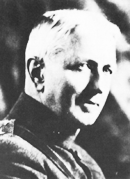 MajGen Ben C. Fuller, Neville's successor in 1930, found new roles and missions for the Corps as 15th Commandant.
MajGen Ben C. Fuller, Neville's successor in 1930, found new roles and missions for the Corps as 15th Commandant.
Marine Corps Historical Collection
------------------------------------------------------
As his term as Commandant came to a close Ben Fuller was able to effect a far-reaching change that John Russell was to carry further into execution. In December 1933, with the approval of the Secretary of the Navy, Fuller redesignated the existing Marine expeditionary forces on both coasts as the Fleet Marine Force (FMF) to be a type command of the U.S. Fleet. Building on the infantrymen
of the 5th Marines at Quantico and those of the 6th Marines at San Diego, two brigades came into being which were the precursors of the 1st and 2d Marine Divisions of World War II. In keeping with the times, Commandant Russell could point out the next year that he had only 3,000 Marines available to man the FMF, but the situation would improve as Marines returned from overseas stations.
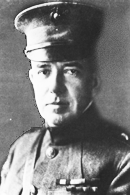 The 16th Commandant of the Marine Corps, MajGen John H. Russell, was a graduate of the Naval Academy, as Lejeune, Neville, and Fuller before him and close to Navy leaders because of their mutual Academy experiences.
The 16th Commandant of the Marine Corps, MajGen John H. Russell, was a graduate of the Naval Academy, as Lejeune, Neville, and Fuller before him and close to Navy leaders because of their mutual Academy experiences.
Marine Corps Historical Collection
------------------------------------------------------
The slowly building brigades and their attendant squadrons of Marine aircraft, the only American troops with combat and expeditionary experience beyond the trenches and battlefields of France, came into being in a climate of change from the "old ways" of performing their mission. At the Marine base at Quantico, Virginia, also the home of advanced officer training for the Corps, a profound event had taken place in November 1933 that would alter the course of the war to come.
That month, all classes of the Marine Corps Schools were suspended and the students and faculty, including a sprinkling of Navy officers, were directed to concentrate their efforts on developing a detailed manual which would provide the guidance for the conduct of amphibious operations. The decision was not purely a Marine Corps once, since Quantico and the staff of the Naval War College at Newport, Rhode Island, had been exchanging ideas on the subject for more than a decode. All naval planners knew that the execution of the contingency operations they envisioned worldwide would be flawed if the United States did not have adequate transport and cargo shipping, appropriate and sufficient landing craft, or trained amphibious assault troops. But the Quantico working group, headed by Colonel Ellis B. Miller, proceeded on the assumption that all these would be forthcoming. They developed operating theories based on their experience and their hopes which could be refined by practice. They formulated answers to thorny questions of command relationships, they looked at naval gunfire and air support problems and provided solutions, they addressed the ship-to-shore movement of troops and developed unloading, boat control, and landing procedures, and they decided on beach party and shore party methods to control the unloading of supplies on the beaches. In January 1934, a truly seminal document in the history of amphibious warfare was completed and the "Tentative Manual for Landing Operations" was published by the Marine Corps. In the years that followed, as fleet landing exercises refined procedures, as the hoped-for improved shipping and landing craft gradually appeared, and as increasing numbers of seamen and assault troops were trained in amphibious landing techniques, the Quantico manual was reworked and expanded, but its core of innovative thinking remained. In 1938 the Navy promulgated the evolved manual as Fleet Training Publication (FTP) 167; it became the bible for the conduct of American amphibious operations in World War II. In 1941 the Army published FTP-167 as Field Manual 31-5 to guide its growing force of soldiers, most of whom would train for and take part in amphibious operations completely unaware of the Marine Corps influence on their activities. Truly, the handful of Marine and Navy officers at Quantico in 1933-34 had revolutionized the conduct of amphibious warfare.
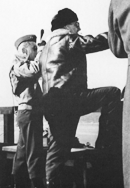 MajGen Holland M. Smith, Commanding General, Amphibious Force, Atlantic Fleet observes landing operations with his aide, Capt Victor H. Krulak, at Fort Story, Virginia, in the winter of 1941.
MajGen Holland M. Smith, Commanding General, Amphibious Force, Atlantic Fleet observes landing operations with his aide, Capt Victor H. Krulak, at Fort Story, Virginia, in the winter of 1941.
Department of Defense Photo (USMC) 528648
------------------------------------------------------
Despite the fiscal constraints of the Depression, the number and variety of naval ships devoted to amphibious purposes gradually increased in the 1930s. As the threat of American involvement in the war also grew stronger, vastly increased funds were made available for the Navy, the country's
"first line of defense," and specialized transport and cargo ships appeared. These were tested and modified and became an increasing factor in the FLEXs which took place every year from 1935 on, usually with practice landing at Culebra and Vieques Islands off Puerto Rico in the Atlantic Ocean, at San Clemente
Island off the southern California coast, and in the Hawaiian Islands.
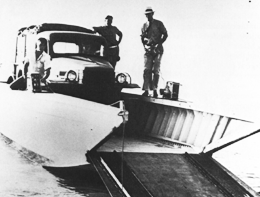 The design of this Higgins landing craft, loaded with a military truck, shown here in May 1941, served as the basis for the landing craft, vehicle and personnel (LCVP).
The design of this Higgins landing craft, loaded with a military truck, shown here in May 1941, served as the basis for the landing craft, vehicle and personnel (LCVP).
Department of Defense Photo (USN) 78312
--------------------------------------
While the number of "big" amphibious ships, transports and cargo vessels, slowly grew in number, the small boat Navy of amphibious landing craft similarly evolved and increased. They were vital to the success of landing operations, a means to get assault troops ashore swiftly and surely. For most Marines of the era, there are memories of ships' launches, lighters, and experimental boats of all sorts that brought them to the beach, or at least to the first sandbar or reef offshore. Rolling over the side of a boat and wading through the surf was a common experience. One future Commandant, then a lieutenant, recalled making a practice landing on Maui in the Hawaiian Islands as his unit returned from expeditionary duty in China in 1938. He described the landing as "one of those old timers" made in "these damned motor launches, you know, with a prow and everything--never made for a landing." The results, he said in colorful memory, was "you grounded out somewhere 50 yards from the beach and jumped in. Sometimes your hat floated and sometimes you made it."
 "Wet" landing net training was conducted for 1st Division Marines off the Intracoastal Waterway at Marine Barracks, New River. Note different landing craft used in the exercise. These Marines soon would be descending the nets at Guadalcanal.
"Wet" landing net training was conducted for 1st Division Marines off the Intracoastal Waterway at Marine Barracks, New River. Note different landing craft used in the exercise. These Marines soon would be descending the nets at Guadalcanal.
Sketch by Vernon H. Bailey, Navy Art Collection
--------------------------------------
The landing craft that changed this picture was the Higgins boat, named after its inventor, Andrew Higgins, who developed a boat of shallow draft that could reach the beach in three to four feet of water, land an infantry platoon, and then retract to return for another load. First used on an experimental basis in FLEX 5 (1938) at Culebra, it won its way over rivals and was adopted as the standard personnel landing craft by 1940. In its initial hundreds the Higgins boat had a sloping bow that required of its passengers an over-the-side agility after it grounded. In 1941, a version, most familiar to World War II veterans, was introduced which had a bow ramp which allowed men and vehicles to exit onto a beach or at least into knee-high, not neck-high water. This was the 36-foot Landing Craft, Vehicle and Personnel
(LCVP) which was fitted to the boat davits on every amphibious transport and cargo vessel. Its companion boat, the 50-foot, ramped Landing Craft, Mechanized
(LCM), also a development of Andrew Higgins, provided the means for landing tanks, artillery, and heavy vehicles.
| Developed and, in part, financed by its inventor, Donald Roebling, the Alligator amphibian tractor is the predecessor of every Landing Vehicle Tracked (LVT) in the world. The story of the Roebling amphibian tractor starts with the devastating hurricanes which struck southern Florida in 1926, 1928, and 1932. Donald Roebling's father, financier John A. Roebling, had witnessed the loss of life brought about by these storms in the swampy areas of the Okeechobee region. Spurred by a challenge from his father to use his engineering talents to design and develop a vehicle "that would bridge the gap between where a boat is grounded and a car is flooded out," Donald Roebling, the grandson of the designer and builder of the Brooklyn Bridge, started work on his Alligator amphibian tractor in early 1933.
Roebling and his staff completed their first model Alligator in early 1935. It used aluminum, a comparatively new and unproven material, in the construction of the hull to reduce weight and increase buoyancy. It was propelled on land and water by paddle-tread tracks and was then powered by a Chrysler 92-horsepower industrial engine. This first model was then modified and upgraded so extensively that it is generally referred to as the second model Alligator. This second Alligator had improved tracks with built-in roller bearings which rode in specially designed steel channels which eliminated the need for idler and bogie wheels to support the tracks, as were used on most tractor and tank designs. In 1937, U.S. Navy Rear Admiral Edward C. Kalbfus, Commander, Battleships, U.S. Pacific Fleet, showed Major General Louis McCarty Little, Commanding General, Fleet Marine Force, an article on Roebling's amphibian tractor in the October 4th issue of Life magazine. In turn, General Little forwarded the article to the Commandant of the Marine Corps. In March 1938, Major John Kaluf of the Equipment Board at Quantico was dispatched to Clearwater, Florida, with orders to investigate the military potential of the Roebling Alligator. Major Kaluf returned a favorable report and in May 1938 the Commandant of the Marine Corps requested that a "pilot model" be purchased for "further tests under service conditions." This request was turned down by the Navy's Bureau of Construction and Repair due to limited funding. In the fall of that year, the new President of the Marine Corps Equipment Board, Brigadier General Emile P. Moses, and Kaluf's replacement as Secretary, Major Ernest E. Linsert, made a visit to Clearwater which would become a turning point in the development of the amphibian tractor. It was during this visit that General Moses persuaded Roebling to design a new Alligator which would incorporate a number of improvements. The fact that the Marine Corps did not have any available funds at this time forced Roebling to come up with most of the $18,000 required to fabricate this vehicle from his own pocket. Construction on this new Alligator was completed in May 1940.
With the political and military situation in Europe and Asia worsening, military appropriations from Congress improved and the Navy's Bureau of Ships was able to fund a $20,000 contract with Roebling for the construction of a new test vehicle. It was almost identical to "Alligator 3," but was powered by a 120-horsepower Lincoln-Zephyr engine. This Alligator was completed in October 1940, and was tested at Quantico, Virginia, and later in the Caribbean. While the testing of this fourth Alligator revealed some deficiencies, the general design was deemed a success. The tractor was redesigned using a welded steel hull and incorporating many of the recommendations of the test team. A contract was then let by the Navy for 100 LVT-1s. The first of the production LVTs would roll off the Food Machinery Corporation's (FMC) assembly line in July 1941. ---Anthony Wayne Tommell |
 |
The variety of landing craft that eventually evolved, and the tasks to which they were put, was limited only by the ingenuity of those who planned their uses and the seamanship of the sailors who manned them. But for the most prewar Marines, the memories of practice landings featured the rampless Higgins boat, various tank lighters which made each beach approach an adventure, and all sorts of "make do" craft of earlier years which were ill suited for surf or heavy seas.
One amphibious craft development of the prewar years, equal in its impact on amphibious landings to the LCVP and the LCM, was the tracked landing vehicle, the LVT. Developed in the late 1930s by Donald Roebling for use as a rescue vehicle in the Florida everglades, the LVT, or the Alligator as it was soon popularly named, could travel over land or water using its cupped treads for propulsion. The stories of the "discovery" of Roebling's invention and of its subsequent testing and development are legion. It proved to have an invaluable capability, not considered in its initial concept; it could cross coral reefs, and coral reefs fringed the beaches of most Pacific islands. The amphibian tractor, or amtrac to its users, was a natural weapon for Marines and there was hardly a whisper of opposition to its adoption. When the first production LVTs rolled off Roebling's assembly line at his plant at Clearwater, Florida, in July 1941, there was already a detachment of Marines at nearby Dunedin learning to drive and maintain the new tractors and to develop tactics for their effective use.
In the new Marine division then forming on each coast there would be a place for an amtrac battalion. The LVTs were conceived at first as a logistics vehicle, a means to carry troops and supplies onto and inshore of difficult beaches. But no sooner did the LVTs make their appearance in significant numbers than the thought occurred that the tractors could be armed and that they could have a role as an assault vehicle, leading assault waves.
Innovations in amphibious shipping and landing craft in the late 30s and early 40s were not solely based on American concepts. With the exception of the LVT, most amphibious craft developments and certainly amphibious shipping developments were influenced by British concepts, requirements, and experience. Although officially neutral in the fighting at sea in the Atlantic and ashore in Europe, the United States was in fact deeply involved in supporting the embattled British. For a long period in 1940-41, the Marine Corps was concerned in this effort, and to the troops in training, particularly those on the east coast, there was a real question whether they might leave their bases for Europe or the Pacific. Marine pilots had a definite fascination with the exploits of the Royal Air Force in its battles with the German Luftwaffe.
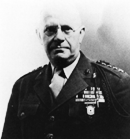 Gen Thomas Holcomb, 17th Commandant of the Marine Corps, was a decorated World War I combat leader. From 1936, when he became Commandant, to December 1943, when he retired, he guided the Corps and led it into war.
Gen Thomas Holcomb, 17th Commandant of the Marine Corps, was a decorated World War I combat leader. From 1936, when he became Commandant, to December 1943, when he retired, he guided the Corps and led it into war.
Department of Defense Photo (USMC) 12444-B
----------------------------------------
Holcomb, who had ably commanded a battalion of the 6th Marines in the fighting in France in 1918, had initially been appointed Commandant by President Roosevelt on 1 December 1936. After serving with distinction through the European outbreak of World War II and the Corps' initial buildup, he was reappointed Major General Commandant by the President for a second four-year term on 1 December 1940. The Commandant, besides being a dedicated Marine who championed the Corps during trying times, was also an astute player of the Washington game. A respected colleague and friend of the admirals who commanded the Navy, Holcomb was equally at ease and a friend to the politicians who controlled the military budget. He understood the President's determination to see Great Britain survive, as well as his admiration of the British peoples' struggle. Always well aware of the value of the public image of the Marine Corps as a force "first to fight," Holcomb at times yielded to pressures to experiment with new concepts and authorize new types of organizations which would enhance that image. The Marines whom he sent to Great Britain were imbued with the desire to gain knowledge and experience that would help the Corps get ready for the war they felt sure was coming.
The British, who shared the view that the Americans would eventually enter the war on their side, were open and forthcoming in their cooperation.
In 1941 particularly, the Marine observers, ranging in rank from captains to colonels, visited British air stations and air control centers, antiaircraft command complexes and firing battery sites, and all kinds of troop formations. The weapons and equipment being used and the tactics and techniques being practiced were all of interest. Much of what was seen and reported on was of immediate value to the Americans and saw enhanced development in the States. On the air side, briefings on radar developments were invaluable, as were demonstrations of ground control intercept practices for night fighters and the use of night fighters themselves. Anything the British had learned on air defense control and antiaircraft usage was eagerly absorbed. The Marine air observers would note on their return that they had dealt with numbers of aircraft and concepts of command and control that were not remotely like Marine Corps reality, but all knew that these numbers of aircraft and their control equipment were authorized, funded, and building.
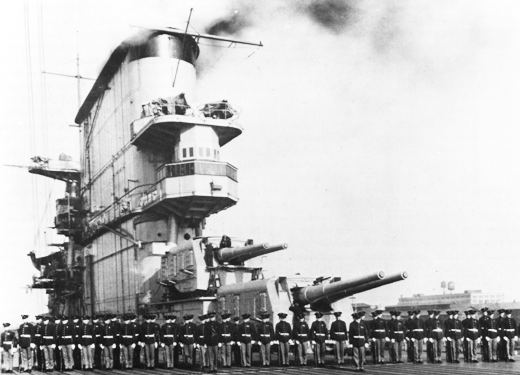 |
| Marines in ships' detachments, such as this one on board the carrier Lexington, served in major combatant ships of the pre-war Navy. Many seagoing Marines were either commissioned or became senior staff noncommissioned officers in the war. Depart of Defense Photo (USN) 51363 |
The fascination of the time, although focused on the Battle of Britain's aerial defenses, was not only with the air war but also with the "elite" troops, the sea-raiding commandos, as well as the glider and parachute forces so ably exploited by the Germans in combat and now a prominent part f Britain's army. The role of the commandos, who were then Army troops but who eventually would be drawn exclusively from Royal Marines ranks, raised a natural favorable response in the American Marines. Most of the observers were enthusiastic about the commando potential, but at least one U.S. Marine senior colonel, Julian C. Smith, who watched commando exercises at Inverary, Scotland, was not overly impressed. Smith, who later commanded the 2d Marine Division at the epic battle for Tarawa, told General Holcomb that the commandos "weren't any better than we; that any battalion of Marines could do the job they do."
For the moment at least, Smith's view was a minority evaluation, one not shared, for instance, by commando enthusiast President Roosevelt, and the Marine Corps would see the raising of raider battalions to perform commando-like missions.
In similar fashion, and for much the same reasons, Service enthusiasm for being at the cutting edge and popular acclaim of elite formations, the Marine Corps raised parachute battalions, glider squadrons, and barrage balloon squadrons, all of which were disbanded eventually in the face of the realities of the island-dominated Pacific theater. They might have served their purpose well in Europe or North Africa but the Marine Corps' destiny was in the Pacific.
Marines of the pre-Pearl Harbor Corps, filled with memories of their later battles with the Japanese, are sometimes prone to forge that Germany was as much their potential enemy in 1940-41 as Japan. At the time, many must have felt ad did one artillery lieutenant and later raider officer who took part in fleet exercises of early 1941 that "we all cut our teeth on amphibious operations, actually not knowing whether we were going to leave Guantanamo for Europe of the Pacific." What the Marines at Guantanamo Bay did know was that their Cuban base was bustling with men as mobilized Reservists and new recruits joined. And as the necessary men came in, the brigade grew in size and abounded with changes of organizations and activations.
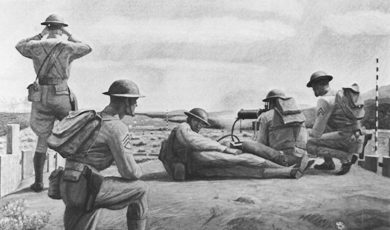 Marines train for war with the Browning .30-caliber, water-cooled, heavy machine gun at Camp Matthews in California.
Marines train for war with the Browning .30-caliber, water-cooled, heavy machine gun at Camp Matthews in California.
Painting by Peter Hurd, U.S. Army Center of Military History
----------------------------------------
The 1st Marine Brigade, at first essentially one infantry regiment, the 5th Marines, one artillery battalion, the 1st Battalion, 11th Marines, and supporting troops, had moved to Guantanamo from Quantico in the late fall of 1940 as its FMF units had outgrown the Virginia base. At "Gitmo," as it was known to all, the brigade's units became the source of all new organizations. Essentially, existing outfits, from battalions through platoons, were split in half. To insure an equal distribution of talent as well as numbers, the brigade commander, Brigadier General Holland N. "Howling Mad" Smith, shrewdly had each unit commander turn in two equal lists, leaving off the commanding officer (CO) and his executive officer. As a later combat battalion commander of the 5th recalled the process, when redesignation took place, "the CO would command one unit, one former exec would become CO of the other ... But until the split was made and the redesignation announced, no CO could know which half he would command. In this manner, the 5th Marines gave
birth to the 7th Marines and the 1st Battalion, 11 Marines to the 2d Battalion. Not too long after, all the units of the 5th, 7th, and 11th Marines and their supporting elements were again split, this time into three equal lists, leaving out the three senior men. A new regiment, the 1st Marines with its necessary support, was formed equitably from the 5th and 7th, because the COs of the older units did not know whether they would stay behind (two lists) or take over the new outfits.
On 12 February 1941, the 1st Marine Brigade was redesignated the 1st Marine Division while its troops were on board ship heading for the Puerto Rican island of Culebra for maneuvers. At the same time on the west coast, the 2d Brigade, at San Diego, which had grown in a similar fashion from its original infantry regiment, the 6th Marines, was redesignated the 2d Marine Division. Most of its troops, however, were located at a new FMF base, Camp Elliott, in the low, hilly country 12 miles northeast of San Diego.
At Marine Corps headquarters, it was readily apparent that the planned expansion of the Corps to an FMF strength of at least two infantry divisions and two supporting aircraft wings would require a vastly increased supporting establishment. Not least among the new requirements for manpower and equipment were those for a new species of units, defense battalions, which were projected to garrison forward bases, including Guantanamo and key American holdings in the Pacific. Also a drawdown on Marine resources was the need to provide guard detachments for many new naval bases and Navy capital ships which were being rushed to completion. The surging demand for men was matched by equal demand for training facilities.
What occurred then in late 1940 and early 1941 was a thorough search by Marines of the east and west coasts of the United States for base sites suitable for training one or more divisions whose main mission was amphibious warfare. Extensive combat exercise areas with direct access to the ocean were required. At the same time, there was a parallel need for suitable airfield locations near the proposed amphibious training sites which would house the planned for but not yet existing squadrons and groups of one or more air wings, each with hundreds of fighter, scout-bomber, torpedo-bomber, and utility aircraft. When the first divisions and wings moved out to combat, the new bases were projected to be training bases for reinforcing and replacement organizations.
Camp Elliott and a group of smaller supporting camps which grew up in its shadow in 1941 were barely adequate to house the growing FMF ground establishment on the west coast. The naval air stations in the San Diego area could still handle the limited number of aircraft available. The same situation was not true of the three major Marine bases in the east. While Quantico's air station could accommodate the planes of Marine Aircraft Group 1, the main base itself was keyed to support specialist and officer training and was not suitable for extensive FMF operations. Swamp-bound Parris Island teemed with recruits and had no room for the FMF. The newly developed outlying camp at nearby Hilton Head Island was reserved for essential defense battalion training. The treaty-restricted area of the naval base at Guantanamo had no room for a reinforced division's 20,000 men.
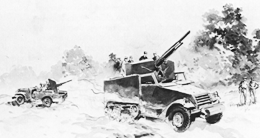 Maneuvering at the Marine Barracks, New River, North Carolina in 1941 is an armored half-tracked mounting a 75mm gun, M1897A4, as well as a 3/4-ton truck carrying a 37mm antitank gun. Later in the war a jeep would pull this weapon.
Maneuvering at the Marine Barracks, New River, North Carolina in 1941 is an armored half-tracked mounting a 75mm gun, M1897A4, as well as a 3/4-ton truck carrying a 37mm antitank gun. Later in the war a jeep would pull this weapon.
Sketch by Vernon H. Bailey, Navy Art Collection
----------------------------------------
Congress authorized the construction of a vast, new Marine base in coastal North Carolina on 15 February 1941. It was, in a sense, a remote area that had been picked, certainly not one near any center of population. The Commandant, writing to a fellow general, commented "those who want to be near big cities will be disappointed because it is certainly out in the sticks," noting however, that it was a great place for maneuvers and amphibious landings. The chosen spot located in the New River area of Onslow County, was described by the 1st Division's World War II historian as "111,170 acres of water, coastal swamp, and plain,
theretofore inhabited largely by sand flies, ticks, chiggers, and snakes." And he might have added covered by pine forest and scrub growth. One of the Marine veterans of the Nicaraguan jungle campaigns said: "Actually, Nicaragua was a much pleasanter place to live than the New River area at the time. They had mosquitoes there with snow on the ground." Despite its perceived faults, the die was cast for New River and construction of a huge tent camp was begun there in April with a projected readiness date of early summer. The famed brick barracks that were a feature of what would become Camp Lejeune were on the architect's drawing boards when Marine Barracks, New River, North Carolina, was activated on the 1st of May.
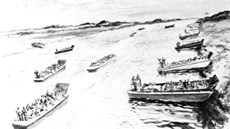 Troops of the 1st Marine Division conduct landing exercises from the Intracoastal Waterway along Onslow Beach at Marine Barracks, New River, North Carolina.
Troops of the 1st Marine Division conduct landing exercises from the Intracoastal Waterway along Onslow Beach at Marine Barracks, New River, North Carolina.
Sketch by Vernon H. Bailey, Navy Art Collection.
----------------------------------------
The 1st Division soon became acquainted with the place that one regimental commander noted was "the only place between Biloxi, Mississippi, and the New Jersey capes where you could make a landing with two divisions abreast." Coming from Guantanamo, the division spent the summer of 1941 landing across Onslow Beach and moving inland through the swamps and pine barrens. By that time, Tent Camp or "Tent City" was ready to receive its new tenants. Strange as it might seem, these 1st Division Marines reveled in their austere setting amidst the stifling heat. They were already contrasting themselves to those on the west coast, derisively labeled "Hollywood Marines," because some units had appeared briefly in movies being shot at the time. There was a feeling, obviously not shared by those in the west, the Paris Island and New River somehow were the most rugged places to endure, n contrast to those who were close to "civilization."
The new Marine airfield, which was to become an integral part of the North Carolina training complex, was formally established on 18 August 1941 when the administrative office for the new "Air Facilities under Development" was established at New Bern, about 40 miles north of New River. Construction there proceeded at the same frenetic pace that marked the development of the ground training center. In September, the administrators moved to the actual airfield site nearby, Cherry Point, and on 1 December Marine Corps Air Station, Cherry Point, was activated. Most of the planes on the east coast were still at Quantico, but a great start had been made on what became in short order the center of a network of training fields which would house enough squadrons and air groups to feed most of the augmentation and replacement demands of four aircraft wings overseas. The actual establishment of the initial wing commands took place at Quantico (1st Marine Aircraft Wing [MAW]) on 7 July 1941 and San Diego (2d MAW) on 19 July. Initially, each wing could count on only one air group as its main strength, Marine Aircraft Group (MAG) 11 in the east and MAG-21 in the west. The vast increase of aircraft and aviation personnel that marked the growth of Marine aviation in World War II was in the works. The pilots, aircrewmen, and mechanics were training at Navy air facilities and the planes were coming off assembly lines in steadily increasing numbers. It was August 1942, however, before the impact of the air buildup would be fully felt at Guadalcanal.
As an all-volunteer force, the Marine Corps was fully deployable during this training and preparedness period. In a sense, the Army was hampered in its readiness by the fact that its draftees, which soon composed the bulk of its strength, could not be sent outside the U.S. without a declaration of war. As a result, when the seizure of the French island of Martinique was contemplated in 1940, the planned assault force was the 1st Marine Brigade. When the perceived threat of a garrison in the Caribbean loyal to Vichy France lessened, other overseas expeditions were also contemplated. In the spring of 1941, the Portuguese Azores became the projected target for an amphibious seizure because it was believed that the Germans might take the strategic islands and thereby seriously threaten the sea lanes of commerce and replenishment for British and Allied bases in the home island, Africa, and the Mediterranean. Again, Marines were to be in the forefront of the landing force and, again, when the perceived threat lessened, the operation was called off.
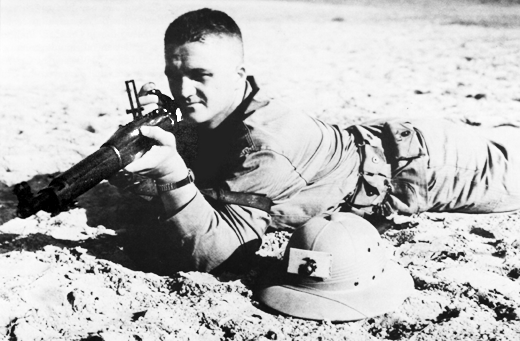 |
| Springfield '03 Rifle |
|---|
| This rifle was the standard issue to all Marines from the early days of the 20th century into the first year of World War II. As a result of intensive marksmanship training, an inseparable bond formed between the individual Marine and this rifle which paid dividends on the target range and, later, in combat.
The Model 1903 "Springfield" rifle traces its development from the experiences of the U.S. Army in combat against the Spanish Army during the Spanish-American War. The clip-fed Spanish 7mm Mauser rifle, Model 1893, had a flatter trajectory and a higher sustained rate of fire than the .30-.40 caliber Krag-Jorgensen rifles used by the U.S. Army. Beginning in 1900, the U.S. Armory in Springfield, Massachusetts, started work on a new service rifle to replace the Krag. The new rifle, officially adopted on 19 June 1903, was based on the M1898 German Mauser and originally had a ramrod bayonet. The rifle was redesigned to accept a knife-type bayonet in 1905. This change was at least partially due to the concern of President Theodore Roosevelt who commented to the Secretary of War that: "I must say that I think the ramrod bayonet is about as poor an invention as I ever saw." The Model 1903 "Springfield" rifle was first issued to Marines in 1908 and saw its first combat during the Nicaraguan Campaign of 1912. The obsolescent Krags were almost entirely supplanted by the new '03 Springfields before the Vera Cruz campaign of 1914. After service in Mexico, Haiti, and the Dominican Republic, the '03 Springfield was exclusively used by marines serving in France with the American Expeditionary Force during World War I. Following the war, an improved version was used by marines in China and in the jungles of the Caribbean Islands and Central America. The accuracy of the '03 Springfield was without peer, and the Marine Corps based its developing marksmanship program on this rifle. The Marine Corps designed an improved set of front and rear sights and soon led the other services in prowess with the rifle. Indeed, by the outbreak of World War II, the Marine Corps had formed a cult around the rifle. -- Kenneth L. Smith-Christmas |
The buildup of forces for the potential Azores campaign did have a profound effect on the Marine Corps, however, despite its cancellation. The core regimental combat team of the 2d Division, the 6th Marines and its supporting units, judged the most ready for active employment, loaded out from San Diego in May 1941 to sail through the Panama Canal and augment the Marine troops on the east coast. Enroute, the Azores objective disappeared and another took its place, Iceland. The strategic island in the middle of the North Atlantic had been occupied by British troops to forestall a similar German move. The British wanted their Iceland occupation troops back in the United Kingdom and asked for Americans to take their place.
When President Roosevelt made the decision to comply with the British request, seeing the move as vital to protecting sea traffic from German raiders, the 6th Marines was at sea and, all unwitting, became the choice for the first American troops to deploy. When the regiment's troop ships reached Charleston, South Carolina, after the Panama passage, the 6th Marines was joined by the 5th Defense Battalion from Parris Island. A new unit, the 1st Marine Brigade (Provisional), was activated. When the ships began to load massive amounts of supplies, including winter protective gear and clothing, the favorite rumor of the Marines, that they were head to a warm and sunny clime, was effectively scotched. The convoy left Charleston soon after and on 7 July 1941 made landfall at Iceland. For nine months thereafter, one of the precious few trained Marine infantry regiments was in garrison in Iceland, and the 2d Division was short a vital element of its strength. The sudden and unexpected deployment of the 6th Marines to the Atlantic was to have a considerable effect on the employment of Marine ground forces in the days after Pearl Harbor.
 |
The drawdown on Marine strength represented by the departure of 5,000 men to Iceland was but a part of the drain of manpower that came about as a result of the fact that Marines could be sent anywhere at any time. In his zeal to support the British in ways short of war, and to enhance American hemispheric defenses, the President in mid-1940 had authorized a swap of 50 overage American destroyers of World War I vintage to Britain in return for 99-year leases to bases at British Atlantic possessions. These bases were all naval and naval bases required Marine guards. As a result, a senior Marine colonel, Omar T. Pfeiffer, was made a member and recorder of a board of naval officers, the Greenslade Board, that surveyed the British locations in the late summer of 1940 to recommend appropriate American base strength and facilities.
Flown first to Bermuda, the board members moved on by air to Argentia, Newfoundland, and Nassau in the Bahamas, and from there touched down at Guantanamo where they boarded the cruiser St. Louis for the rest of their journey. Sailing to Kingston, Jamaica; Port-of-Spain, Trinidad; and Georgetown, British Guyana, the board then checked the islands of Tobago, St. Lucia, and Antigua. At each of these places, it was determined that a Marine guard detachment was needed and 50-to-100-man companies were activated for that purpose in January 1941 so that the Marines could guard the facilities as they were built. It was not bad duty for the men involved, but their deployment meant a battalion less for the FMF.
Colonel Pfeiffer was a participant in British-American discussions of
possible measures to be taken in the event of war with Germany and Japan (the Rainbow Plan) which took place in Washington in 1940 and 1941. In April 1941 he was posted to a new position as Fleet Marine Officer in the Pacific Fleet at Pearl Harbor which drew fully on his expertise and experience.
Despite the possible and actual overseas deployments of Marines in the Atlantic Theater throughout 1941, the weight of Marine commitment was in the Pacific. And there was no question of the potential enemy there. It was Japan.
The chance of Japan accepting any of these stipulations vanished with the German invasion of Russia in June. Freed from the threat of the Russians, the Japanese moved swiftly to occupy southern Indochina and reinforced their armed forces by calling up all reservists and increasing conscriptions. In the face of this new proof of Japanese intent, President Roosevelt froze all Japanese assets in the United States, effectively severing commercial relations between the two countries.
In October, a new militaristic government headed by General Hideki Tojo seized power in Tokyo, and a new special ambassador, Saburo Kurusu, was sent to Washington, ostensibly to revitalize negotiations for a peaceful settlement of differences. Short of a miracle, however, the Japanese Army and Navy leaders did not consider peace a likely outcome of the talks with the Americans. They were, in fact, preparing to go to war.
If war came, U.S. Marines would be among the first to experience its violence. In China, Marines had a garrison role in foreign concessions at Shanghai, Peiping, and Tientsin, and in the Philippines, they had sizeable guard units at the naval bases at Cavite and Olongapo on Luzon Island. They provided as well ships' detachments for the woefully few cruisers of the Asiatic Fleet headquartered at Manila. In the Western Pacific's Marina Islands, there was a small naval station on the Navy-governed island of Guam, a certain Japanese wartime target.
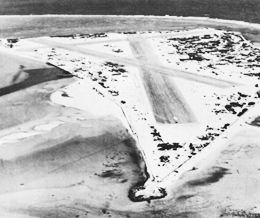 An oblique aerial view looking northeast of Midway's Eastern Island and its airstrip.
An oblique aerial view looking northeast of Midway's Eastern Island and its airstrip.
Department of Defense Photo (USMC) 144602
----------------------------------------
American Samoa in the southeast Pacific, whose islands were also a Navy responsibility, was strategically vital as guardian of the sea routes to New Zealand and Australia from the States. At Pago Pago on Tutuila, American Samoa's largest island, there was a deep harbor and a lightly manned naval base. Recognizing its isolation and vulnerability to Japanese attack, the Navy began deploying Marines to augment its meager garrison late in 1940. The advance party of Marines who arrived at Pago Pago on 21 December were members of the 7th Defense Battalion, which had been formally activated at San Diego on the 16th.
Initially a small composite outfit of 400 men, the 7th had a headquarters battery, and infantry company, and an artillery battery as well as a detail whose task it was to raise and train a battalion of Samoan natives as Marine infantrymen.
The Samoans, who were American nationals, would help the 7th defend Tutuila's 52 square miles of mountainous and jungled terrain. The defense battalion's main body reached Pago Pago in March 1942 and the 1st Samoan Battalion, Marine Corps Reserve, came into being in August. The Marines in Samoa, thinly manning naval coast defense and antiaircraft guns at Pago Pago and patrolling Tutuila's many isolated beaches were acutely aware that their relative weakness invited Japanese attack. They shared this heightened sense of danger with the Marines in the western Pacific, in China, on Luzon, and at Guam, as well as other defense battalion Marines who were gradually manning the island outposts guarding Hawaii. These few thousand men all knew that they stood a good chance of proving once again the time-honored Marine Corps recruiting slogan "First to Fight," if war came.
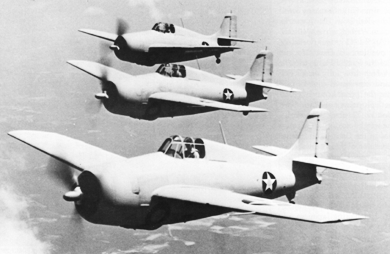 F4F-3 Grumman Wildcats, such as these of Marine Fighting Squadron (VMF) 211, flew off the deck of the Enterprise to Wake Island's new but unfinished airfield. From the island, the Wildcats were to rise to defend Wake against its attackers.
F4F-3 Grumman Wildcats, such as these of Marine Fighting Squadron (VMF) 211, flew off the deck of the Enterprise to Wake Island's new but unfinished airfield. From the island, the Wildcats were to rise to defend Wake against its attackers.
National Archives Photo 127-N-29309
----------------------------------------
In 1938, the Navy's Hepburn Board had determined that four small American atolls to the south and west of Pearl Harbor should be developed as American naval air bases and defended by naval aircraft and Marine garrisons. The two largest atolls of the four were Wake, 2,000 miles west of Hawaii in the central Pacific near the Japanese Marshall Islands group, and Midway, 1,150 miles from Oahu, and not far from the international date line. Both islands were way stations for Pan American clipper service to the Orient. Midway also served as a relay station for the trans-Pacific cable. Eight hundred miles southwest of Pearl Harbor lay Johnston Atoll, whose main island could accommodate an airfield and a small garrison. Palmyra, 1,100 miles south of Hawaii, had barely enough room for an airstrip and a bob-tailed defense force. The island of Wake and Midway each had room enough to accommodate a battalion of defending Marines as well as airfields to hold several squadrons of patrol and fighter aircraft.
The Navy's 14th Naval District, which encompassed the Hawaiian Islands and the outpost atolls, as well as Samoa, was responsible for building defenses and providing garrisons, both ground and air. The Marine contingents were the responsibility of Colonel Harry K. Pickett, Marine Officer of the 14th District and Commanding Officer, Marine Barracks, Pearl Harbor Navy Yard. Preliminary surveys of the atolls and Samoa were conducted by members of Pickett's staff in 1940 and early 1941. Civilian contractors were selected to build the airfields and their supporting installations, but most of the work on the coast defense and antiaircraft gun positions, the bunkers and beach defenses, fell to the lot of the Marines who were to man them. Midway was slated to have a full
defense battalion as its garrison, Wake drew about half a battalion at first, and Johnston and Palmyra were allotted reinforced batteries.
By late 1941, the standard table of organization of a defense battalion had evolved to include a unit of about 900 men, composed of three 5-inch coast defense gun batteries, three 3-inch antiaircraft gun batteries, a sound locator and searchlight battery, a battery of .50-caliber antiaircraft machine guns, and a battery of .30-caliber machine guns for beach defenses. That was the standard; the actuality varied with the location. The characteristic all defense battalion garrisons had in common was lots of guns and gun crews. What they were all short of was infantrymen. If an enemy landing force reached the island beaches, the gun crews and other specialists could expect, and would be expected, to prove once again that every Marine was a rifleman before all else.
The 1st and 3d Defense Battalions were the first Marines to reach the island outposts. Advance elements of the 3d Battalion landed at Midway in May 1940 to conduct reconnaissance and undertake preliminary construction [see the Historical Monograph Marines at Midway for an in-depth account]. The rest of the battalion remained at Pearl Harbor providing reinforcing and relief parties until January 1941 when the whole battalion was ordered forward. In February, while the men of the 3d were unloading their heavy equipment at Midway, the advance party of the 1st Battalion left San Diego on board the carrier Enterprise , transferring at Pearl to a small cargo ships, and moving on to Johnston, where two 5-inch guns and an eight-man caretaker detail landed, while the rest of the party, three officers and 45 enlisted men, proceeded to Palmyra. After the rest of the 1st Defense Battalion shipped out to Pearl Harbor, small reinforcing detachments moved forward to me outpost island to join in the pick and shovel work of emplacing guns and digging in command posts, magazines, and fire direction centers. It was August 1941 before the first elements of the 1st Battalion reached Wake where a contractor's work force was already building an airfield [see the Historical Monograph The Defense of Wake for an in-depth account].
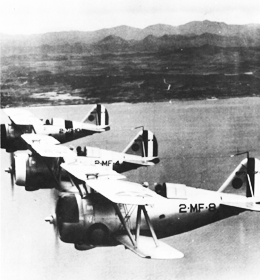 Grumman F3F-2s, the last biplane fighter produced for either the Navy or the Marines, served in the FMF from 1937 to 1941. The VMF-2 planes pictured here were stationed at North Island, Coronado near San Diego, California during this period.
Grumman F3F-2s, the last biplane fighter produced for either the Navy or the Marines, served in the FMF from 1937 to 1941. The VMF-2 planes pictured here were stationed at North Island, Coronado near San Diego, California during this period.
Department of Defense Photo (USN) 83924
------------------------------
On all the outpost island where Marines were stationed, the work was constant and boring. The arrival of a plane or ship was an event to celebrate. There was no liberty. If there had been, there was no place to go and nothing to see but the Pacific in all directions. The 14th District established a rotation policy (back to Pearl) for the outpost Marines, but this reward was countered by a pervading urgency to get on with the job at hand, protecting the approaches to Hawaii.
The 6th Defense Battalion, which arrived at Pearl Harbor in January 1941 as a replacement and reserve unit, moved forward to Midway in September to replace the 3d Battalion as the defending ground garrison. The 3d moved back to Oahu for a well earned rest from construction work. On 1 December, the 4th Defense Battalion, fresh from duty at Guantanamo Bay, arrived at Pearl. It was scheduled to replace the half battalion of the 1st on Wake, but its arrival and strengthened force was too late to effect relief. Wake did receive a substantial and welcome reinforcement on 4 December, however, when 12 F4F-3 Grumman Wildcats of Marine Fighting Squadron (VMF) 211 flew off the decks of the Enterprise to the atoll's new and unfinished airfield.
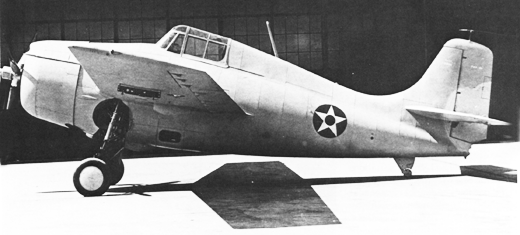 |
| Grumman F4F Wildcat |
|---|
| The Grumman Wildcat served as the primary fighter of the United States Marine Corps
at the outbreak of the Pacific War. By December 1941, Grumman Wildcats were being flown by
three of four Marine fighter squadrons then in existence.
Designed in 1936 as Grumman's first monoplane fighter aircraft, the Wildcat had retractable handcranked landing gear, vacuum-powered flaps, and a simple electrical system. Although it lost a design contest to its main competitor, the Brewster F2A Buffalo, in 1938, the Navy nonetheless continued to encourage Grumman in the aircraft's development. Wildcats were delivered to the Marine Corps in 1941, replacing the obsolescent Grumman F3F-2 fabric and metal biplanes which had been in service since 1937. The all-metal F4F-3 Wildcat was powered by a Pratt & Whitney R-1830-66 Twin Wasp engine and had two .50-caliber Browning machine guns mounted in each wing. By October 1941, Marine Fighting Squadrons (VMFs) 111, 121, and 211 were fully equipped with Wildcats; only VMF-221 was equipped with Brewster Buffaloes. A forward detachment from Marine Fighting Squadron 211 flew to Wake Island in December 1941 as part of a Marine Corps air-ground team just prior to the Japanese attack on Pearl Harbor. During the following defense of Wake Island, they fought the Japanese for 14 days and inflicted heavy losses on the attackers' shipping and aircraft before losing all 12 F4F-3s. Despite the fact that the Wildcat's performance was inferior to its primary adversary, the Japanese Zero, its staunch ruggedness and greatly superior firepower in the hands of skilled and determined pilots would enable it to compile a distinguished record during the war. There were 34 recorded Marine Corps Wildcat aces. --Kenneth L. Smith-Christmas |
The spread of Defense battalion Marines at the beginning of December found 422 officers and men of the 1st Battalion at Wake, 162 at Johnston, 158 at Palmyra, and 261 at Pearl Harbor. Midway's 6th Battalion garrison had 33 officers and 810 enlisted men. The 3d Battalion was 863 strong at Pearl and the newly arrived 4th mustered 818. Both of the larger atolls had six 5-inch coast defense guns and twelve 3-inch antiaircraft guns; Johnston had two 5-inch guns and four 3-inch guns; Palmyra had four of each. Machine guns for defense matched the garrisons' size; Midway had 30 .50-calibers and 30 .30-calibers; Wake had 18 and 30; Johnston and Palmyra each had eight apiece.
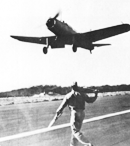 A SB2U-3 Change-Vought Vindicator scout-bomber conducts field carrier landing practice at Ewa Field in June 1941.
A SB2U-3 Change-Vought Vindicator scout-bomber conducts field carrier landing practice at Ewa Field in June 1941.
Department of Defense Photo (USMC) 145098
----------------------------------------
Although VMF-211's Wildcats on Wake were the only Marine aircraft yet to reach the outpost defenses, most of the squadron's parent Marine Aircraft Group 21 had moved from California to Hawaii by December. MAG-21 was the 2d Wing's only tactical air group. Part of the group's ground echelon moved west to Midway in November to await aircraft due to arrive shortly. Meanwhile, all Marine aircraft in Hawaii were concentrated at the Marine Corps Air Station, Ewa, 10 miles west of Pearl Harbor, the site of a Navy dirigible mooring mast filed in the 1920s. Those planes of MAG-21 not at the airfield were deployed on board carriers for transportation to reinforce Wake and Midway. VMF-221 with 14 F2A-3 Brewster Buffalo fighters boarded the Saratoga at North Island, San Diego on 7 and 8 December. The Lexington got 18 SB2U-3 Chance-Vought Vindicators of Marine Scout-Bombing Squadron 231. With the fall of Wake, both squadrons were used to reinforce Midway. At Ewa, there were 48 fighters, scout-bombers, and utility aircraft, most scheduled for forward deployment.
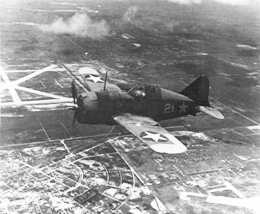 The F2A-3 Brewster Buffalo single-engine fighter planes with which the Marine Corps entered World War II were almost all lost in the Battle of Midway.
The F2A-3 Brewster Buffalo single-engine fighter planes with which the Marine Corps entered World War II were almost all lost in the Battle of Midway.
Department of Defense Photo (USMC) 25414
----------------------------------------
Aviation units were not the only elements of the FMF to move forward into the Pacific by December 1941. A sizeable portion of the 2d Marine Division's 2d Engineer Battalion was also deployed to Oahu in the fall in order to build a camp capable of accommodating 5,000 Marines. The location of the new facility, Camp Catlin, was in the canefields east of Honolulu along the island's main highway. Its site selected by a board of Marine colonels, Catlin eventually would see tens of thousands of Marines pass through its gates into the farthest reaches of the Pacific as it became the principal replacement and redistribution center for the FMF. In December it was half completed, and its Marine engineer constructors were destined to be the first members of the 2d Division to see combat in World War II.
Back in California, the 2d Marine Division was rounding into shape, engaged as was the 1st Division in constant training and maneuvers. Neither unit had reached its full strength yet as constant demands for Marines for base, fleet, and barracks duty drained the available manpower pool as fast as it filled. San Diego's recruit depot was crowded with men striving to become Marines, but it no longer had to call on the 2d Division for extra drill instructors as it had often in 1940 after the President declared a National Emergency and the recruiting stations were flooded with applicants. The recruit training cycle, down to as few as 24 days on both coasts in 1940, was fairly stable at seven weeks, with three on the rifle range.
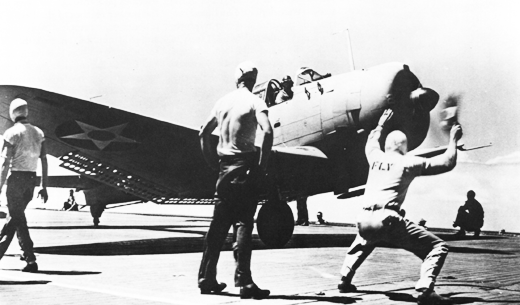 A SBD-3 Douglas Dauntless dive bomber runs-up for takeoff from the flight deck of the Saratoga in late 1941. The Dauntless was a multi-seat, low-wing monoplane which carried a 500-pound bomb under the fuselage and bombs under the wings.
A SBD-3 Douglas Dauntless dive bomber runs-up for takeoff from the flight deck of the Saratoga in late 1941. The Dauntless was a multi-seat, low-wing monoplane which carried a 500-pound bomb under the fuselage and bombs under the wings.
Department of Defense Photo (USN) 92493
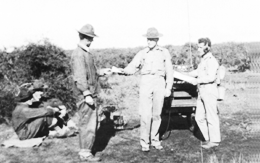 For training in the field before World War II, Marines wore either summer service khaki or one-piece blue denim coveralls with their field hats. The Marines at left are communicators with state of the art equipment at Camp Elliott in 1941.
For training in the field before World War II, Marines wore either summer service khaki or one-piece blue denim coveralls with their field hats. The Marines at left are communicators with state of the art equipment at Camp Elliott in 1941.
Photo courtesy of C.M. Craig
----------------------------------------
The Fleet Marine Force units in the west, like those in the east, were itching for action, although the Commandant noted at the time that Marines still needed "to train (further) for combat," a quite different situation. Most of the planes and crewmen of the 2d Wing were already at least as far west as Hawaii. The 2d Division was poised to join them.
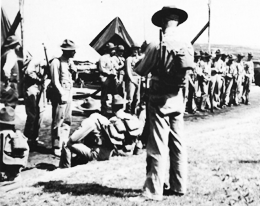 Every Marine in the prewar era was required to qualify annually with his T/O weapon and generally spent two weeks in preparing to fire for record. Here, West Coast FMF troops are at the La Jolla rifle range in 1940 for their weapons training.
Every Marine in the prewar era was required to qualify annually with his T/O weapon and generally spent two weeks in preparing to fire for record. Here, West Coast FMF troops are at the La Jolla rifle range in 1940 for their weapons training.
Photo courtesy of C.M. Craig
----------------------------------------
Still in the future, the near future, were the great air and amphibious training centers at El Toro and Camp Pendleton. Pendleton, in particular, was to be part of the experiences of most Marines who served in e Pacific either going or coming. In December 1941, the area, as one private on its original survey team remembered, was "pretty barren country" fit only for cattle. His observations was not an uncommon sentiment of later Marines, who followed him into the seemingly endless brown hills and valleys.
Beyond the continental limits of the United States, Marines do duty as the frontiersmen of the nation's huge new defense network. The existing stations from the Philippines to the Virgin Islands have had their garrisons increased. The Navy's new bases -- Iceland, Newfoundland, Bermuda, Santa Lucia, Antigua, Trinidad, Jamaica, British Guiana, Dutch Harbor, Samoa, Kodiak, the Hawaiian Island group, and other outlying stations -- all are garrisoned and guarded, at least partially, by United States Marines.
On the same day, he wrote to Brigadier General John Marston, commanding the 1st Provisional Brigade in Iceland, telling him that it was "important to get the Brigade Home" and promising "you can be sure that we will leave no stone unturned to accomplish it." Its men were wanted back in the 2d Marine Division and the arrival of U.S. Army reinforcements in strength in Iceland gave the Marine Corps strong argument for the recovery of its forces. The fact that the Marines had come under Army command did nothing to lessen the urgency of the situation.
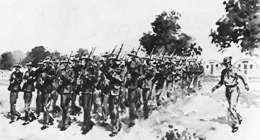 Marine recruits are drilled on the parade ground at Parris Island in the early 1940s. Note the sun helmets on the troops as they march to the cadence of the DI.
Marine recruits are drilled on the parade ground at Parris Island in the early 1940s. Note the sun helmets on the troops as they march to the cadence of the DI.
Sketch by Vernon H. Bailey, Navy Art Collection
----------------------------------------
In his radio report, the Commandant did not mention the Marines stationed in China, perhaps because the decision had been made to withdraw them. In September, the American Consul-General at Shanghai, the Navy commander of the Yangtze River Patrol, and the Commanding Officer, 4th Marines had jointly recommended that all U.S. naval forces in China be pulled out of Japanese-controlled territory, a recommendation heartily endorsed by the Commander, Asiatic Fleet. The authorization for the evacuation was delayed by States and Navy Department negotiations until 10 November and it was the 27th before the first of two chartered passenger lines, the President Madison, loaded half the 4th Marines and its equipment and departed Shanghai. The next day, the rest of the regiment boarded the President Harrison and sailed.
| Helmets of World War II |
|---|
| One of the most noticeable changes in the Marine Corps uniform at the outset of World War II was the transition from the M1917A1 helmet reminiscent of World War I to the familiar M1 helmet of World War II, Korea, and Vietnam.
At the outbreak of World War II, Marines were wearing a modernized version of the helmet first introduced to Marines serving in France during World War I. The American M1917 helmet was nearly identical to the British "Brodie Pattern" helmet. In 1939, this helmet was superceded in the Marine Corps by the improved M1917A1 helmet (as shown below, worn by men of the 6th Marines in Iceland). The padded leather liner and two-piece canvas chinstrap of this updated version of the "tin hat," as it was then called, made it far more comfortable and sturdier than its predecessor. The steel helmet shell remained the same. In the Marine Corps, the helmet was worn both with and without insignia and, while most Marines wore the helmet in the rough olive drab paint, some units, most notably those in China, burnished, waxed, and polished theirs. Less than two years after the Marine Corps' adoption of the M1917A1, a U.S. Army research team at Fort Benning under [the command] of Major Harold G. Sydenham, began working on a new design for a two-piece helmet which offered far more protection for the wearer. Adopted by the government as the M1 helmet on 9 June 1941, the Hadfield manganese steel helmet was first made by the McCord Radiator Company of Detroit, Michigan, while the fiber liner was manufactured by the Hawley Products Company. At the suggestion of General George S. Patton, the liner's suspension system was patterned after a design by John T. Riddell that was used in contemporary football helmets. The new helmet was issued to the Marine Corps in the spring and early summer of 1942 and, by the time of the Guadalcanal campaign later that summer, had all but supplanted the old "dishpan" helmet. -- Kenneth L. Smith-Christmas Photo courtesy of Col James A. Donovan, USMC (Ret) |
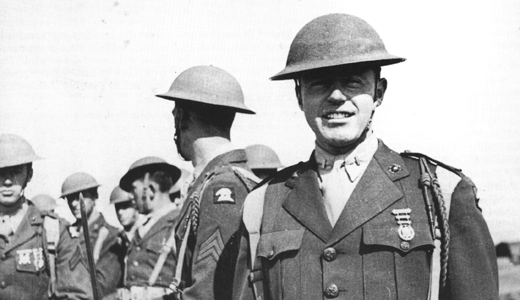 |
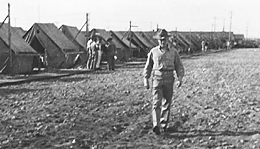 Scene at Camp Elliott in spring 1941. The new base, near San Diego, was activated in mid-1940. It housed west coast FMF units and also served for advanced training.
Scene at Camp Elliott in spring 1941. The new base, near San Diego, was activated in mid-1940. It housed west coast FMF units and also served for advanced training.
Photo courtesy of Col James A. Donovan, USMC (Ret)
----------------------------------------
The destination of both liners was the naval base at Olongapo in the Philippines where the 4th was to join the naval forces defending the islands, in particular the 1st Separate Battalion at Cavite. The ships arrived on 30 November and 1 December. The President Harrison, as planned, was unloaded quickly in order to return to China and pick up the Marines stationed at Peiping and Tientsin, but it was too late. The Japanese Pearl Harbor attack force was already well on its way to its target.
The embassy guard detachments in China were assembling their gear to ship out through the all-weather port of Chinwangtao. The small Marine camp there was named Camp Holcomb, a fact that annoyed the
----------------------------------------
In 1940, Fleet Marine Force units stationed at the San Diego Recruit Depot conducted some small unit training in the open fields of the Mission Bay area, in khaki uniforms with the 1903 Springfield rifle, and wearing World War I helmets.
Photo courtesy of Col James A. Donovan, USMC (Ret)
Commandant somewhat as he believed no Marine facilities should be named after living persons. He pointed out in his 22 November letter to General Marston that the camp still bore his name "but it will be a thing of the past in a few days." The Commandant was obviously referring to the impending evacuation of the embassy Marines, but in fact these men, trapped in a hopeless situation, less than 200 in number, were captured on the first day of the war.
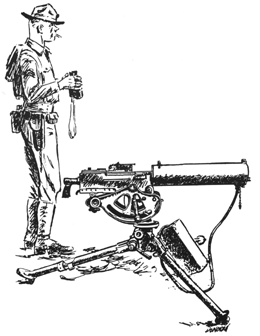 Prewar Marine infantry battalions each rated 12 of these Browning .30-caliber, 1917 water-cooled machine guns. The overall weight of the gun with its tripod was 85 pounds. Each weapon had a cyclic rate of fire of 400-520 rounds per minute.
Prewar Marine infantry battalions each rated 12 of these Browning .30-caliber, 1917 water-cooled machine guns. The overall weight of the gun with its tripod was 85 pounds. Each weapon had a cyclic rate of fire of 400-520 rounds per minute.
Sketch by Col James A. Donovan, USMC (Ret), Marine Corps Art Collection
----------------------------------------
In a general sense, the Marine Corps was ready to fight on 7 December 1941, as it has always been regardless of its size. Nearly a third of the Corps' strength was already overseas deployed to stations and outposts, where it shared, often with Navy and Army forces, the challenge of being in the forefront of battle if war came. The few thousand Marines who could realistically picture themselves at risk of immediate attack embodied the spirit of thousands more who knew their turn would come.
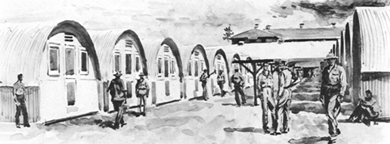 These Quonset huts at Marine Corps Recruit Depot, Parris Island, South Carolina, housed the large influx of recruits at the beginning of the war. Recruits were also billeted in barracks and tents at the depots on both coasts until late 1945.
These Quonset huts at Marine Corps Recruit Depot, Parris Island, South Carolina, housed the large influx of recruits at the beginning of the war. Recruits were also billeted in barracks and tents at the depots on both coasts until late 1945.
Sketch by Vernon H. Bailey, Navy Art Collection
----------------------------------------
In the immediate future, once war began, the Corps would grow to unheralded numbers, far beyond what any prewar Marine had imagined. The nucleus of Marines that would give strength to this vast assemblage, almost half a million men and women by 1944, was already in place in 1941.
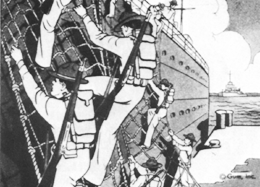 Cargo Net Landing One of the things that have been said about the Marines is that they are "first ashore and at the scene of action." This means that the men who join Uncle Sam's Marine Corps must be well trained in the duty of getting ashore quickly. One of their drills that teaches them to make a rapid landing from their transport employs a cargo net slung over the ship's side. With their rifles dangling from their shoulders the "Leathernecks" line up on the deck of the ships. Then at a given signal they climb over the side, using the cargo net as a rather unsteady ladder. The first men down grab opposite side of the net to help steady it for those who follow. For training purposes the men land on a stationary platform or pier over which the cargo net is hung (see picture).
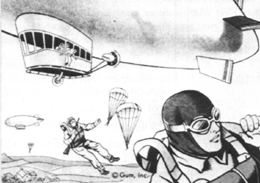 Marine Sky Troops Not to be outdone by their Soldier cousins, the "Soldiers of the Sea"--the United States Marines--have also been experimenting with Parachute Troops. This new idea of landing troops from the sky promises to be a valuable addition to Marine training, fitting nicely into their landing party duty. Similar to the training of Army Sky Troops, the Marines who volunteer for this service practice jumping from various heights to become skillful in making a sudden landing from the sky. They attempt to drop from lower and lower heights to cut down the time it takes to reach the earth and thus to lessen the danger of discovery by the enemy. The 'chute opens automatically. There is also an emergency 'chute which can be opened by the jumper if necessary. The picture shows a detachment of jumpers being dropped from a slow-moving Navy blimp during an initial stage of training. |
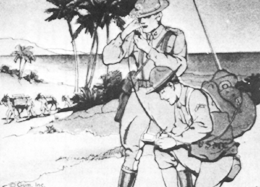 Field Radio The problem of field detachments of troops keeping in touch with headquarters and bases of supplies is today largely solved by radio. At the Marine Radio Operators School, selected marines have an opportunity to study elementary radio theory, elementary electricity, radio sending and receiving, typing, Naval radio procedure and field radio sets. It qualifies them for positions of greater trust and responsibility while in Service for Uncle Sam and fits them for good-paying positions on the outside when their period of enlistment is ended. In the picture two marines are operating a portable radio sending and receiving set in the field. In this case they are keeping in touch with headquarters aboard a transport anchored in the harbor a good many miles away.
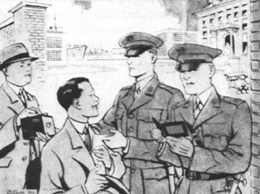 Shore Duty On shore marines live in large barracks or Service buildings where they can be quickly mobilized for emergencies. When stationed on shore at the Navy Yards and at Naval Stations their duties are to protect government property from theft, injury, or fire, and to prevent disorders of any kind. They also perform duties as infantrymen, artillerymen, machine gunners, signal men, motor transport, and occasionally as mounted infantry. The picture shows marines on Guard Duty in a Navy Yard during a war emergency. At these times the regulations are tightened and the marines have to be on the alert to prevent suspicious-looking individuals from gaining any information that would be harmful to Uncle Sam's interest. Save to get all these picture cards showing Uncle Sam's soldiers, sailors, marines, airmen and civilians in training for National Defense. GUN, INC., Phila., Pa. Printed in the U.S.A., 1941 |
|
Popular bubblegum cards printed in 1941 illustrate how the American public viewed the Marines of the prewar period. Collector cards donated by LtGen William R. Maloney, USMC (Ret) | |
The generals were all veterans of World War I, Caribbean, and China service; the officers who would lead the battalions and regiments, squadrons and air groups in the first months of war were also veterans of extensive foreign and expeditionary duty. Many of the company commanders and flight leaders were products of the 1930s when the Marine Corps wisely recruited the pick of Army ROTC honor graduates. The pilots of all ranks, although as yet only a few hundred in number, were skilled and capable, men who could look forward to leading thousands of men who were in the training pipeline.
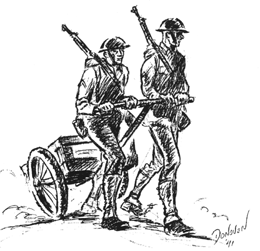 Handy items in the prewar Fleet Marine Force were Cole carts, used to carry such weapons as heavy machine guns and their tripods, 81mm mortars and their base plates, and ammunition for all the weapons in the infantry battalion.
Handy items in the prewar Fleet Marine Force were Cole carts, used to carry such weapons as heavy machine guns and their tripods, 81mm mortars and their base plates, and ammunition for all the weapons in the infantry battalion.
Sketch by Col James A. Donovan, USMC (Ret), Marine Corps Art Collection
---------------------------------------
Dominating the whole scene of Corps mobilization and increases in strength was a solid core of noncommissioned officers who had shared the veteran officers' experiences and who were, in the words of many qualified to comment, truly "the backbone of the Corps." In a real way, these sergeants and corporals of whatever stripe were the ones who epitomized the Marine Corps traditions of leaderships and loyalty to fellow Marines. They imbued in the men with whom they served a feeling of what it means to be a Marine, of what it takes to be a Marine.
In the war that was t come, on the eve of the Pearl Harbor attack, these Marines of all ranks had a strong identity with the past. They were the inventors, in General Holcomb's words in his 1941 Marine Corps Birthday message, of "this high name of distinction and soldierly repute" won for all by "those who have preceded us in the Corps." The prewar Marines, both boot and veterans, were to add immeasurably to the Corps' laurels and traditions in the first year of fighting at Wake, Guam, Bataan, Corregidor, Midway, Makin, and Guadalcanal. Throughout the course of World War II, they were the men of "The Old Corps" whose accomplishments set the standard for all Marines.
| Marine Corps Strength and Dispositions 30 November 1941 | ||||
|---|---|---|---|---|
|
Continental U.S. (non-FMF) Major Bases (5) Posts and Stations (43) Headquarters and Staff Recruiting (4 Districts) Total
Continental U.S. (FMF) TOTAL of CHART: |
14,707 10,089 780 847 26,423
64,641 |
Overseas (non-FMF) Posts and Stations (24) Tactical Units 4th Marines (801) 1st Separate Bn (725) 1st Marine Brigade (Provisional) (3,972) Ships' Detachments (68) Total
Overseas (FMF) TOTAL MARINE CORPS: |
3,367 5,498 3,793 12,658
65,881 |
|
Other histories of value for this period include: Col Robert D. Heinl, Jr., Soldiers of the Sea: The United States Marine Corps, 1775-1962 (Annapolis: U.S. Naval Institute, 1962); Allan R. Millett, Semper Fidelis: The History of the United States Marine Corps (New York: Macmillan Publishing Company, 1980); and Robert Sherrod, History of Marine Corps Aviation in World War II (Washington: Combat Forces Press, 1952).
All oral history transcripts addressing the prewar years in the Oral History Collection, Marine Corps Historical Center, Washington, D.C., were examined. The interviews with the following officers were found particularly useful:
Col James R. Aichele; BGen Charles L. Banks; MajGen Robert Blake; Col Justice M. Chambers; MajGen John P. Condon; Gen Robert E. Cushman, Jr.; LtGen Karl S. Day; MajGen Marion L. Dawson; LtGen Pedro A. del Valle; BGen Lester A. Dessez; BGen Edward C. Dyer; LtGen George F. Good, Jr.; MajGen Louis R. Jones; MajGen Raymond L. Murray; LtGen Herman Nickerson; MajGen Omar T. Pfeiffer; LtGen Donn J. Robertson; and LtGen Julian C. Smith.
The Personal Papers Collection of the Historical Center was also consulted for relevant material. The correspondence of Gen Thomas Holcomb, MajGen William P. Upshur, and Gen Alexander A. Vandegrift contain many significant letters that bear upon the prewar period.
In addition to researching, writing, and editing significant portions of the prewar years narrative in the above mentioned Pearl Harbor to Guadalcanal, the author also consulted the histories of the 1st and 2d Marine Divisions and was fortunate enough to talk with many of the Marines mentioned in the oral history references about their experiences.
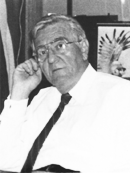 Henry I. Shaw, Jr., former chief historian of the History and Museums Division,
was a Marine Corps historian from 1951-1990. He attended The Citadel, 1943-1944,
and was graduated with a bachelor of arts cum laude in history from Hope College,
Holland, Michigan. He received a master of arts degree in history from Columbia University.
Mr. Shaw served as a Marine in both World War II and the Korean War.
He is the co-author of four of the five volumes of the official history of Marine Corps
operations in World War II and was the senior editor of most of the official histories
of Marines in Vietnam. In addition, he has written a number of brief Marine Corps histories.
Mr. Shaw has written many articles on military history for professional publications
and has had more than 50 signed book reviews appearing in such publications as
Military Collector & Historian, Military Affairs, Marine Corps Gazette, Leatherneck,
The Washington Post, New York Historical Society Quarterly, and the
United States Naval Institutes Proceedings.
Henry I. Shaw, Jr., former chief historian of the History and Museums Division,
was a Marine Corps historian from 1951-1990. He attended The Citadel, 1943-1944,
and was graduated with a bachelor of arts cum laude in history from Hope College,
Holland, Michigan. He received a master of arts degree in history from Columbia University.
Mr. Shaw served as a Marine in both World War II and the Korean War.
He is the co-author of four of the five volumes of the official history of Marine Corps
operations in World War II and was the senior editor of most of the official histories
of Marines in Vietnam. In addition, he has written a number of brief Marine Corps histories.
Mr. Shaw has written many articles on military history for professional publications
and has had more than 50 signed book reviews appearing in such publications as
Military Collector & Historian, Military Affairs, Marine Corps Gazette, Leatherneck,
The Washington Post, New York Historical Society Quarterly, and the
United States Naval Institutes Proceedings.
Editorial costs of preparing this pamphlet have been defrayed in part by a bequest from the estate of Emilie H. Watts, in memory of her late husband, Thomas M. Watts, who served as a Marine and was the recipient of a Purple Heart.
DIRECTOR OF MARINE CORPS HISTORY AND MUSEUMS
Brigadier General Edwin H. Simmons, USMC (Ret)
MANAGING EDITOR,
WORLD WAR II COMMEMORATIVE SERIES
Benis M. Frank
EDITING AND DESIGN SECTION, HISTORY AND MUSEUMS DIVISION
Robert E. Struder, Senior Editor; W. Stephen Hill, Visual Information
Specialist; Catherine A. Kerns, Composition Services Technician
Marine Corps Historical Center
Building 58, Washington Navy Yard
Washington, D.C. 20374-0580
1991
PCN 190 003115 00
Transcribed and formatted for HTML by Patrick Clancey, HyperWar Foundation